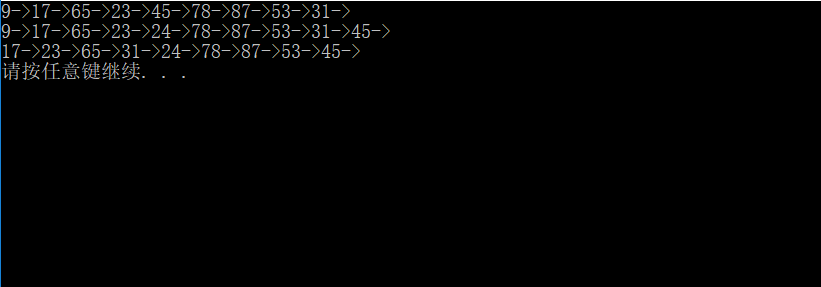堆是一种特殊的树形数据结构,每个结点都有一个值。通常我们所说的堆的数据结构,是指二叉堆。堆的特点是根结点的值最小(或最大),且根结点的两个子树也是一个堆
堆分为大根堆,小根堆,大根堆就是树的根结点值最大,小根堆就是树的根结点值最小。
Heap.h
#pragma once
#include<stdio.h>
#include<stdlib.h>
#include<assert.h>
#include<malloc.h>
typedef int DataType;
typedef struct Heap
{
DataType* _array;
int _capacity;
int _size;
}Heap,*pHeap;
// 创建堆
void CreateHeap(Heap* hp, DataType* array, int size);
// 在堆中插入值为data的元素
void InsertHeap(Heap* hp, DataType data);
// 获取堆顶元素
DataType TopHeap(Heap* hp);
// 检测一个堆是否为空堆
int EmptyHeap(Heap* hp);
// 获取堆中元素的个数
int SizeHeap(Heap* hp);
// 删除堆顶元素
void DeleteHeap(Heap* hp);
// 销毁堆
void DestroyHeap(Heap* hp);
/////////////////////////////////////////////////////辅助函数
void AdjustDown(Heap* hp,int parent);
void AdjustUp(Heap* hp, int child);
void swap(DataType* pleft, DataType* pright);
void AdjustUp(Heap* hp, int child);
int CheckCapacity(Heap* hp);
void print(Heap* hp);
Heap.c
#include"Heap.h"
// 创建堆
void CreateHeap(Heap* hp, DataType* array, int size)
{
int i = 0;
int root = ((size - 2) >> 1);
//给堆申请空间
hp->_array = (DataType*)malloc(sizeof(DataType) * size);
if (NULL == hp->_array)
{
assert(0);
return;
}
hp->_capacity = size;
//放置元素
for (;i < size;i++)
{
hp->_array[i] = array[i];
}
hp->_size = size;
//调整
for (;root >= 0;--root)
{
//向下调整
AdjustDown(hp,root);
}
}
void AdjustDown(Heap* hp, int parent)
{
//child标记parent结点左右子树中最小的孩子
//默认左孩子最小
int child = parent * 2 + 1;
while (hp->_size > child)
{
//找左右孩子中最小的一个
if (hp->_size > child + 1 && hp->_array[child] > hp->_array[child + 1])
{
child += 1;
}
if (hp->_array[parent] > hp->_array[child])
{
swap(&hp->_array[parent],&hp->_array[child]);
parent = child;
child = parent * 2 + 1;
}
else
{
return;
}
}
}
void swap(DataType* pleft, DataType* pright)
{
assert(pleft);
assert(pright);
DataType tmp;
tmp = *pleft;
*pleft = *pright;
*pright = tmp;
}
void AdjustUp(Heap* hp, int child)
{
int parent = (child - 1) >> 1;
while (child)
{
if (hp->_array[parent] > hp->_array[child])
{
swap(&hp->_array[parent], &hp->_array[child]);
child = parent;
parent = (child - 1) >> 1;
}
else
return;
}
}
int CheckCapacity(Heap* hp)
{
assert(hp);
if (hp->_capacity == hp->_size)
{
//申请新空间
int newCapacity = hp->_capacity * 2;
DataType* ptemp = (DataType*)malloc(sizeof(DataType) * newCapacity);
if (NULL == ptemp)
{
assert(0);
return 0;
}
//拷贝元素
for (int i = 0;i < hp->_size;++i)
{
ptemp[i] = hp->_array[i];
}
//释放旧空间
free(hp->_array);
hp->_array = ptemp;
hp->_capacity = newCapacity;
}
}
// 在堆中插入值为data的元素
void InsertHeap(Heap* hp, DataType data)
{
//向上调整
assert(hp);
//检测容量
CheckCapacity(hp);
//插入元素,将待插入元素放置最后一个元素之后
hp->_array[hp->_size++] = data;
//重新排序
AdjustUp(hp, hp->_size - 1);
}
// 获取堆顶元素
DataType TopHeap(Heap* hp)
{
assert(hp);
return hp->_array[0];
}
// 检测一个堆是否为空堆
int EmptyHeap(Heap* hp)
{
assert(hp);
return 0 == hp->_size;
}
// 获取堆中元素的个数
int SizeHeap(Heap* hp)
{
assert(hp);
return hp->_size;
}
// 删除堆顶元素
void DeleteHeap(Heap* hp)
{
if (EmptyHeap == NULL)
return;
swap(&hp->_array[0],&hp->_array[hp->_size - 1]);
hp->_size -= 1;
AdjustDown(hp,0);
}
// 销毁堆
void DestroyHeap(Heap* hp)
{
assert(hp);
if (hp->_array)
{
free(hp->_array);
hp->_capacity = 0;
hp->_size = 0;
}
}
void print(Heap* hp)
{
assert(hp);
int i = 0;
for (;i < hp->_size;i++)
{
printf("%d->",hp->_array[i]);
}
printf("\n");
}
void test()
{
Heap hp;
int array[] = { 53,17,78,9,45,65,87,23,31 };
CreateHeap(&hp,array,sizeof(array)/sizeof(array[0]));
print(&hp);
InsertHeap(&hp,24);
print(&hp);
DeleteHeap(&hp);
print(&hp);
}
int main()
{
test();
system("pause");
return 0;
}
优化:大小堆可选
Heap.h
#pragma once
#include<stdio.h>
#include<stdlib.h>
#include<assert.h>
#include<malloc.h>
typedef int DataType;
typedef int (*Compare)(DataType left, DataType right);//接受两个指针类型的参数,返回一个整形的函数指针
typedef struct Heap
{
DataType* _array;
int _capacity;
int _size;
Compare com;
}Heap,*pHeap;
// 创建堆
void CreateHeap(Heap* hp, DataType* array, int size, Compare com);
// 在堆中插入值为data的元素
void InsertHeap(Heap* hp, DataType data);
// 检测堆是否为空
int EmptyHeap(Heap* hp);
// 获取堆中元素的个数
int SizeHeap(Heap* hp);
// 获取堆顶元素
DataType TopHeap(Heap* hp);
// 删除堆顶的元素
void DeleteHeap(Heap* hp);
// 销毁堆
void DestroyHeap(Heap* hp);
// 用于元素比较的比较器
// 小于号
int Less(DataType left, DataType right);
// 大于好
int Greater(DataType left, DataType right);
/////////////////////////////////////////////////////辅助函数
void AdjustDown(Heap* hp,int parent);
void AdjustUp(Heap* hp, int child);
void swap(DataType* pleft, DataType* pright);
void AdjustUp(Heap* hp, int child);
int CheckCapacity(Heap* hp);
void print(Heap* hp);
Head.c
#include"Heap.h"
// 创建堆
void CreateHeap(Heap* hp, DataType* array, int size, Compare com)
{
int i = 0;
int root = ((size - 2) >> 1);
//给堆申请空间
hp->_array = (DataType*)malloc(sizeof(DataType) * size);
if (NULL == hp->_array)
{
assert(0);
return;
}
hp->_capacity = size;
//放置元素
for (;i < size;i++)
{
hp->_array[i] = array[i];
}
hp->_size = size;//初始化
hp->com = com;//初始化
//调整
for (;root >= 0;--root)
{
//向下调整
AdjustDown(hp,root);
}
}
void AdjustDown(Heap* hp, int parent)
{
//child标记parent结点左右子树中最小的孩子
//默认左孩子最小
int child = parent * 2 + 1;
while (hp->_size > child)
{
if (hp->_size > child + 1 && hp->com(hp->_array[child + 1] , hp->_array[child]) )
{
child += 1;
}
if (hp->com(hp->_array[child], hp->_array[parent]))
{
swap(&hp->_array[parent],&hp->_array[child]);
parent = child;
child = parent * 2 + 1;
}
else
{
return;
}
}
}
void swap(DataType* pleft, DataType* pright)
{
assert(pleft);
assert(pright);
DataType tmp;
tmp = *pleft;
*pleft = *pright;
*pright = tmp;
}
void AdjustUp(Heap* hp, int child)
{
int parent = (child - 1) >> 1;
while (child)
{
if (hp->com(hp->_array[child], hp->_array[parent]))
{
swap(&hp->_array[parent], &hp->_array[child]);
child = parent;
parent = (child - 1) >> 1;
}
else
return;
}
}
int CheckCapacity(Heap* hp)
{
assert(hp);
if (hp->_capacity == hp->_size)
{
//申请新空间
int newCapacity = hp->_capacity * 2;
DataType* ptemp = (DataType*)malloc(sizeof(DataType) * newCapacity);
if (NULL == ptemp)
{
assert(0);
return 0;
}
//拷贝元素
for (int i = 0;i < hp->_size;++i)
{
ptemp[i] = hp->_array[i];
}
//释放旧空间
free(hp->_array);
hp->_array = ptemp;
hp->_capacity = newCapacity;
}
return 0;
}
// 在堆中插入值为data的元素
void InsertHeap(Heap* hp, DataType data)
{
//向上调整
assert(hp);
//检测容量
CheckCapacity(hp);
//插入元素,将待插入元素放置最后一个元素之后
hp->_array[hp->_size++] = data;
//重新排序
AdjustUp(hp, hp->_size - 1);
}
int Less(DataType left, DataType right)
{
assert(left);
assert(right);
return left < right;
}
// 大于好
int Greater(DataType left, DataType right)
{
assert(left);
assert(right);
return left > right;
}
// 获取堆顶元素
DataType TopHeap(Heap* hp)
{
assert(hp);
return hp->_array[0];
}
// 检测一个堆是否为空堆
int EmptyHeap(Heap* hp)
{
assert(hp);
return 0 == hp->_size;
}
// 获取堆中元素的个数
int SizeHeap(Heap* hp)
{
assert(hp);
return hp->_size;
}
// 删除堆顶元素
void DeleteHeap(Heap* hp)
{
if (EmptyHeap == NULL)
return;
swap(&hp->_array[0],&hp->_array[hp->_size - 1]);
hp->_size -= 1;
AdjustDown(hp,0);
}
// 销毁堆
void DestroyHeap(Heap* hp)
{
assert(hp);
if (hp->_array)
{
free(hp->_array);
hp->_capacity = 0;
hp->_size = 0;
}
}
void print(Heap* hp)
{
assert(hp);
int i = 0;
for (;i < hp->_size;i++)
{
printf("%d->",hp->_array[i]);
}
printf("\n");
}
void test()
{
Heap hp;
int array[] = { 53,17,78,9,45,65,87,23,31 };
CreateHeap(&hp,array,sizeof(array)/sizeof(array[0]),Greater);
print(&hp);
CreateHeap(&hp, array, sizeof(array) / sizeof(array[0]), Less);
print(&hp);
}
int main()
{
test();
system("pause");
return 0;}
优化时使用了函数指针:点击打开链接 点击打开链接 点击打开链接 点击打开链接

